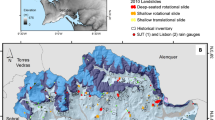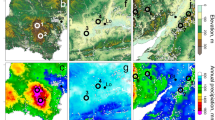Abstract
Markov chain geostatistics is a methodology for simulating categorical fields. Its fundamental model for conditional simulation is the Markov chain random field (MCRF) model, with the transiogram serving as its basic spatial correlation measure. There are different methods to obtain transiogram models for MCRF simulation based on sample data and expert knowledge: linear interpolation, mathematical model joint-fitting, and a mixed approach combining both. This study aims to explore the sensitivity of the MCRF model to different transiogram jointing modeling methods. Two case studies were conducted to examine how simulated results, including optimal prediction maps and simulated realization maps, vary with different sets of transiogram models. The results indicate that all three transiogram joint modeling methods are applicable, and the MCRF model exhibits a general insensitivity to transiogram models produced by different methods, particularly when sample data are sufficient to generate reliable experimental transiograms. The variations in overall simulation accuracies based on different sets of transiogram models are not significant. However, notable improvements in simulation accuracy for minor classes were observed when theoretical transiogram models (generated by mathematical model fitting with expert knowledge) were utilized. This study suggests that methods for deriving transiogram models from experimental transiograms perform well in conditional simulations of categorical soil variables when meaningful experimental transiograms can be estimated. Employing mathematical models for transiogram modeling of minor classes provides a way to incorporate expert knowledge and improve the simulation accuracy of minor classes.
Similar content being viewed by others
Data Availability
Data sets generated during the current study are available from the corresponding author on reasonable request.
References
Arnold, D.B., Milne, W.J.: The use of Voronoi tessellations in processing soil survey results. IEEE Comput. Graph Appl. 4(3), 22–28 (1984)
Bierkens, M.F.P., Burrough, P.A.: The indicator approach to categorical soil data. J. Soil Sci. 44(2), 369–381 (1993)
Carle, S.F., Fogg, G.E.: Transition probability-based indicator geostatistics. Math. Geol. 28(4), 453–476 (1996)
Carle, S.F., Fogg, G.E.: Modeling spatial variability with one and multidimensional continuous-lag Markov chains. Math. Geol. 29(7), 891–918 (1997)
Casella, G., Berger, R.L.: Statistical inference, 2nd edn. Duxbury Press, Pacific Grove (2002)
Deutsch, C.V., Journel, A.G.: GSLIB: geostatistical software library and users guide. Oxford University Press, New York (1998)
Ethier, V.G.: Application of Markov analysis to the Banff formation (Mississippian), Alberta. J. Int. Assoc. Math. Geol. 7(1), 47–61 (1975)
Goovaerts, P.: Geostatistics in soil science: state-of-the-art and perspectives. Geoderma 89(1–2), 1–45 (1999)
Isaaks, E.H., Sarivastava, R.: An introduction to applied geostatistics. Oxford University Press, New York (1989)
Jaffray, J.Y.: Bayesian updating and belief functions. IEEE Trans. Syst. Man. Cybern. 22(5), 1144–1152 (1992)
Li, W.: Markov chain random fields for estimation of categorical variables. Math. Geol. 39(3), 321–335 (2007a)
Li, W.: Transiograms for characterizing spatial variability of soil classes. Soil Sci. Soc. Am. J. 71(3), 881–893 (2007b)
Li, W., Zhang, C.: A random-path Markov chain algorithm for simulating categorical soil variables from random point samples. Soil Sci. Soc. Am. J. 71(3), 656–668 (2007)
Li, W., Zhang, C.: A single-chain-based multidimensional Markov chain model for subsurface characterization. Environ. Ecol. Stat. 15(2), 157–174 (2008)
Li, W., Zhang, C.: Linear interpolation and joint model fitting of experimental transiograms for Markov chain simulation of categorical spatial variables. Int. J. Geogr. Inf. Sci. 24(6), 821–839 (2010)
Li, W., Zhang, C.: Markov chain random fields in the perspective of spatial bayesian networks and optimal neighborhoods for simulation of categorical fields. Comput. GeoSci. 23(5), 1087–1106 (2019)
Li, W., Zhang, C., Dey, D.K.: Modeling experimental cross-transiograms of neighboring landscape categories with the gamma distribution. Int. J. Geogr. Inf. Sci. 26(4), 599–620 (2012)
Li, W., Zhang, C., Dey, D.K., Willig, M.R.: Updating categorical soil maps using limited survey data by Bayesian Markov chain cosimulation. Sci. World J. 2013, 587284 (2013)
Li, W., Zhang, C., Willig, M.R., Dey, D.K., Wang, G., You, L.: Bayesian Markov chain random field cosimulation for improving land cover classification accuracy. Math. Geosci. 47(2), 123–148 (2015)
Luo, J.: Transition probability approach to statistical analysis of spatial qualitative variables in geology. In: Forster, A., Merriam, D.F. (eds.) Geologic modeling and mapping, pp. 281–299. Plenum Press, New York (1996)
Matheron, G.: Principles of geostatistics. Econ. Geol. 58(8), 1246–1266 (1963)
Meerschman, E., Van Meirvenne, M., Van De Vijver, E., De Smedt, P., Islam, M.M., Saey, T.: Mapping complex soil patterns with multiple-point geostatistics. Eur. J. Soil Sci. 64(2), 183–191 (2013)
Pearl, J.: Fusion, propagation, and structuring in belief networks. Artif. Intell. 29(3), 241–288 (1986)
Schwarzacher, W.: The use of Markov chains in the study of sedimentary cycles. Math. Geol. 1, 17–39 (1969)
Strebelle, S.: Conditional simulation of complex geological structures using multiple-point statistics. Math. Geol. 34, 1–21 (2002)
Webster, R., Oliver, M.A.: Geostatistics for environmental scientists. Wiley, Chichester (2007)
Yu, J., Li, W., Zhang, C.: A framework of experimental transiogram modelling for Markov chain geostatistical simulation of landscape categories. Comput. Environ. Urban. Syst. 73, 16–26 (2019)
Zhai, R., Li, W., Zhang, C., Zhang, W., Wang, W.: The transiogram as a graphic metric for characterizing the spatial patterns of landscapes. Landscape Ecol. 34(9), 2103–2121 (2019)
Zhang, C., Li, W.: Regional-scale modelling of the spatial distribution of surface and subsurface textural classes in alluvial soils using Markov chain geostatistics. Soil Use Manag. 24(3), 263–272 (2008)
Zhang, C., Li, W.: A comparative study of nonlinear Markov chain models for conditional simulation of multinomial classes from regular samples. Stoch. Environ. Res. Risk Assess. 22(2), 217–230 (2008)
Zhang, W., Li, W., Zhang, C., Zhao, T.: Parallel computing solutions for Markov chain spatial sequential simulation of categorical fields. Int. J. Digit. Earth 12(5), 566–582 (2019)
Author information
Authors and Affiliations
Corresponding author
Ethics declarations
Competing interests
The authors have no competing interests to declare that are relevant to the content of this article.
Additional information
Publisher’s Note
Springer Nature remains neutral with regard to jurisdictional claims in published maps and institutional affiliations.
Rights and permissions
Springer Nature or its licensor (e.g. a society or other partner) holds exclusive rights to this article under a publishing agreement with the author(s) or other rightsholder(s); author self-archiving of the accepted manuscript version of this article is solely governed by the terms of such publishing agreement and applicable law.
About this article
Cite this article
Zhang, B., Li, W. & Zhang, C. Sensitivity analysis of the MCRF model to different transiogram joint modeling methods for simulating categorical spatial variables. Comput Geosci (2024). https://doi.org/10.1007/s10596-024-10294-x
Received:
Accepted:
Published:
DOI: https://doi.org/10.1007/s10596-024-10294-x




